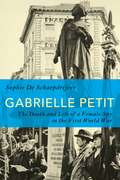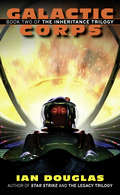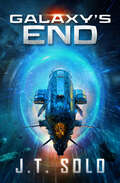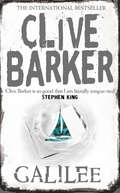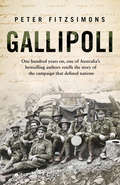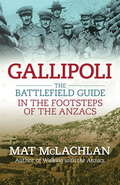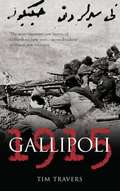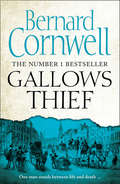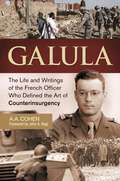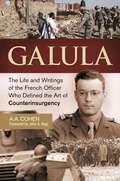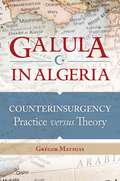- Table View
- List View
The G3 Battle Rifle (Weapon #68)
by Leroy ThompsonDuring the Cold War, the G3 was one of the world's pre-eminent battle rifles. Developed in France and Spain after 1945, the rifle was produced by the German arms manufacturer Heckler & Koch. Adopted by more than 40 countries and produced on licence by many more, it was widely employed during colonial wars in Africa, insurgencies in Latin America and conflicts in the Middle East, but perhaps its widest use was in the Iran–Iraq War. Variants of the G3 have also seen substantial usage among Special Forces including Britain's Special Boat Service and the US Navy SEALs. Semi-automatic versions, especially the HK91 and HK93, remain popular in the United States, and the G3-derived HK11 and HK21 family of light machine guns have also been widely adopted by military and law-enforcement units across the world. Fully illustrated with specially commissioned artwork, this study examines one of the iconic weapons of the Cold War era.
Gabrielle Petit: The Death and Life of a Female Spy in the First World War
by Sophie De SchaepdrijverIn central Brussels stands a statue of a young woman. Built in 1923, it is the first monument to a working-class woman in European history. Her name was Gabrielle Petit. History has forgotten Petit, an ambitious and patriotic Belgian, executed by firing squad in 1916 for her role as an intelligence agent for the British Army. After the First World War she was celebrated as an example of stern endeavour, but a hundred years later her memory has faded. In the first part of this historical biography Sophie De Schaepdrijver uses Petit's life to explore gender, class and heroism in the context of occupied Europe. Petit's experiences reveal the reality of civilian engagement under military occupation and the emergence of modern espionage. The second part of the book focuses on the legacy and cultural memory of Petit and the First World War. By analysing Petit's representation in ceremony, discourse and popular culture De Schaepdrijver expands our understanding of remembrance across the 20th century.
Gabrielle Petit: The Death and Life of a Female Spy in the First World War
by Sophie De SchaepdrijverIn central Brussels stands a statue of a young woman. Built in 1923, it is the first monument to a working-class woman in European history. Her name was Gabrielle Petit. History has forgotten Petit, an ambitious and patriotic Belgian, executed by firing squad in 1916 for her role as an intelligence agent for the British Army. After the First World War she was celebrated as an example of stern endeavour, but a hundred years later her memory has faded. In the first part of this historical biography Sophie De Schaepdrijver uses Petit's life to explore gender, class and heroism in the context of occupied Europe. Petit's experiences reveal the reality of civilian engagement under military occupation and the emergence of modern espionage. The second part of the book focuses on the legacy and cultural memory of Petit and the First World War. By analysing Petit's representation in ceremony, discourse and popular culture De Schaepdrijver expands our understanding of remembrance across the 20th century.
Galactic Corps: Star Strike, Galactic Corps, Semper Human (The Inheritance Trilogy #2)
by Ian DouglasWar is forever The people on Earth no longer remember how the human race was nearly obliterated centuries earlier during the terror visited upon them by the merciless Xul. But the Star Marines, thirty thousand light years from home, know all too well the horror that still lives.
Galaxy's End (Galaxy's End Ser.)
by J. T. SoloJ. T. Solo&’s Galaxy&’s End is perfect for classic science fiction fans wanting more spaceships, wormholes, interplanetary travel, and space drama. This futuristic story is a breathtaking ride.
Galilee: A Novel Of The Fantastic
by Clive BarkerA massive tale of secrets, corruption and magic between two feuding families – the powerful Gearys and the shadowy Barbarossas.
The Gallery of Miracles and Madness: Insanity, Art And Hitler's First Mass-murder Programme
by Charlie English‘A riveting tale, brilliantly told' Philippe Sands The little-known story of Hitler’s war on modern art and the mentally ill.
Gallipoli: The Dardanelles Disaster in Soldiers' Words and Photographs (Battleground Gallipoli Ser.)
by Richard Van Emden Stephen ChambersPresenting more than 150 never-before-published photographs of the campaign, many taken by the soldiers themselves, together with unpublished written material from British, Anzac, French and Turkish, including eyewitness accounts of the landings, this is an unrivalled account of what really happened at Gallipoli. Van Emden's gripping narrative and lucid analysis of Churchill's infamous operation, complements Chambers's evocative images, showing how the rapid spread of diseases like dissentry, the lack of clean water and food, the tremendous losses on both sides affected morale, until finally in January 1916, in what were the best-laid plans of the entire disastrous campaign, the Allies successfully fooled the Turkish forces and evacuated their troops from the peninsula with no additional casualties.Leading First World War historian Richard van Emden and Gallipoli expert Stephen Chambers have produced an entirely fresh, personal and illuminating study of one of the Great War's most catastrophic events.
Gallipoli: Command Under Fire
by Edward J EricksonUnique among World War I campaigns, the fighting at Gallipoli brought together a modern amphibious assault and multi-national combined operations. It took place on a landscape littered with classical and romantic sites – just across the Dardanelles from the ruins of Homer's Troy. The campaign became, perhaps, the greatest 'what if' of the war. The concept behind it was grand strategy of the highest order, had it been successful it might have led to conditions ending the war two years early on Allied terms. This could have avoided the bloodletting of 1916–18, saved Tsarist Russia from revolution and side stepped the disastrous Treaty of Versailles – in effect, altering the course of the entire 20th century. This study is the first to focus on operational and campaign-level decisions and actions, which drove the conduct of the campaign. It departs from emotive first-hand accounts and offers a broader perspective of the large scale military planning and maneuvering involved in this monstrous struggle on the shores of European Turkey.
Gallipoli
by Peter FitzSimonsOn 25 April 1915, Allied forces landed on the Gallipoli Peninsula in present-day Turkey to secure the sea route between Britain and France in the west and Russia in the east. After eight months of terrible fighting, they would fail...To this day, Turkey regards the victory as a defining moment in its history, a heroic last stand in the defence of the Ottoman Empire. But, counter-intuitively, it would come to signify something perhaps even greater for the defeated allies, in particular the Australians and New Zealanders: the birth of their countries’ sense of nationhood. Now, in the year that marks its centenary, the Gallipoli campaign (commemorated each year on 25 April, Anzac Day), resonates with significance as the origin and symbol of Australian and New Zealand identity. As such, the facts of the campaign (which was minor when compared to the overall scale of the First World War: Australian deaths were less than a sixth of their losses on the Western Front) are often forgotten or obscured. Now the celebrated journalist and author Peter FitzSimons, with his trademark vibrancy and expert melding of writing and research, recreates the disastrous campaign as experienced by those who endured it or perished in the attempt.
Gallipoli: Great Battles (Great Battles)
by Jenny MacleodThe British-led Mediterranean Expeditionary Force that attacked the Ottoman Empire at Gallipoli in 1915 was a multi-national affair, including Australian, New Zealand, Irish, French, and Indian soldiers. Ultimately a failure, the campaign ended with the withdrawal of the Allied forces after less than nine months and the unexpected victory of the Ottoman armies and their German allies. In Britain, the campaign led to the removal of Churchill from his post as First Lord of the Admiralty and the abandonment of the plan to attack Germany via its 'soft underbelly' in the East. Thereafter, it was largely forgotten on a national level, commemorated only in specific localities linked to the campaign. In post-war Turkey, by contrast, the memory of Gallipoli played an important role in the formation of a Turkish national identity, celebrating both the ordinary soldier and the genius of the republic's first president, Mustafa Kemal. The campaign served a similarly important formative role in both Australia and New Zealand, where it is commemorated annually on Anzac Day. For the southern Irish, meanwhile, the bitter memory of service for the King in a botched campaign was forgotten for decades. Shaped initially by the imperatives of war-time, and the needs of the grief-stricken and the bereft, the memory of Gallipoli has been re-made time and again over the last century. For the Turks an inspirational victory, for many on the Allied side a glorious and romantic defeat, for others still an episode best forgotten, 'Gallipoli' has meant different things to different people, serving by turns as an occasion of sincere and heartfelt sorrow, an opportunity for separatist and feminist protest, and a formative influence in the forging of national identities.
Gallipoli: Great Battles (Great Battles)
by Jenny MacleodThe British-led Mediterranean Expeditionary Force that attacked the Ottoman Empire at Gallipoli in 1915 was a multi-national affair, including Australian, New Zealand, Irish, French, and Indian soldiers. Ultimately a failure, the campaign ended with the withdrawal of the Allied forces after less than nine months and the unexpected victory of the Ottoman armies and their German allies. In Britain, the campaign led to the removal of Churchill from his post as First Lord of the Admiralty and the abandonment of the plan to attack Germany via its 'soft underbelly' in the East. Thereafter, it was largely forgotten on a national level, commemorated only in specific localities linked to the campaign. In post-war Turkey, by contrast, the memory of Gallipoli played an important role in the formation of a Turkish national identity, celebrating both the ordinary soldier and the genius of the republic's first president, Mustafa Kemal. The campaign served a similarly important formative role in both Australia and New Zealand, where it is commemorated annually on Anzac Day. For the southern Irish, meanwhile, the bitter memory of service for the King in a botched campaign was forgotten for decades. Shaped initially by the imperatives of war-time, and the needs of the grief-stricken and the bereft, the memory of Gallipoli has been re-made time and again over the last century. For the Turks an inspirational victory, for many on the Allied side a glorious and romantic defeat, for others still an episode best forgotten, 'Gallipoli' has meant different things to different people, serving by turns as an occasion of sincere and heartfelt sorrow, an opportunity for separatist and feminist protest, and a formative influence in the forging of national identities.
Gallipoli: The battlefield guide
by Mat McLachlanThe essential travel companion for anyone visiting Gallipoli.Each year, thousands of Australians visit Gallipoli to pay homage and see where their forebears fought, suffered and died. Anzac Cove, Quinn's Post, Lone Pine - the iconic places where our national legend was forged.In this essential and authoritative guide, practical information is combined with historical detail, alongside revealing and often heartrending quotes from the letters and diaries of the Anzacs themselves.- Detailed easy-to-follow plans for walking and driving tours across the main battlefields- Maps, photos and historical commentary to put the campaign in context- Everything you need to know where to go, where to stay and how to get there.Walk where the Anzacs walked, see where they fought and marvel at their courage.
Gallipoli: The End of the Myth
by Robin PriorThe Gallipoli campaign of 1915–16 was an ill-fated Allied attempt to shorten the war by eliminating Turkey, creating a Balkan alliance against the Central Powers, and securing a sea route to Russia. A failure in all respects, the operation ended in disaster, and the Allied forces suffered some 390,000 casualties. This conclusive book assesses the many myths that have emerged about Gallipoli and provides definitive answers to questions that have lingered about the operation.Robin Prior, a renowned military historian, proceeds step by step through the campaign, dealing with naval, military, and political matters and surveying the operations of all the armies involved: British, Anzac, French, Indian, and Turkish. Relying substantially on original documents, including neglected war diaries and technical military sources, Prior evaluates the strategy, the commanders, and the performance of soldiers on the ground. His conclusions are powerful and unsettling: the naval campaign was not “almost” won, and the land action was not bedeviled by “minor misfortunes.” Instead, the badly conceived Gallipoli campaign was doomed from the start. And even had it been successful, the operation would not have shortened the war by a single day. Despite their bravery, the Allied troops who fell at Gallipoli died in vain.
Gallipoli: Command Under Fire
by Prof. Edward J EricksonUnique among World War I campaigns, the fighting at Gallipoli brought together a modern amphibious assault and multi-national combined operations. It took place on a landscape littered with classical and romantic sites – just across the Dardanelles from the ruins of Homer's Troy. The campaign became, perhaps, the greatest 'what if' of the war. The concept behind it was grand strategy of the highest order, had it been successful it might have led to conditions ending the war two years early on Allied terms. This could have avoided the bloodletting of 1916–18, saved Tsarist Russia from revolution and side stepped the disastrous Treaty of Versailles – in effect, altering the course of the entire 20th century. This study is the first to focus on operational and campaign-level decisions and actions, which drove the conduct of the campaign. It departs from emotive first-hand accounts and offers a broader perspective of the large scale military planning and maneuvering involved in this monstrous struggle on the shores of European Turkey.
Gallipoli 1915: Frontal Assault on Turkey (Campaign)
by Philip HaythornthwaiteThe Gallipoli expedition of 1915, the brainchild of Winston Churchill, was designed to knock the Turkish Empire out of the First World War and open a supply route to Russia. The campaign is characterised by the military incompetence of the higher commands, particularly the Allies. However, in spite of this, Gallipoli deserves to be, and is, also remembered for the heroism and resourcefulness of both the British army and the men of the Australian and New Zealand Army Corps. This book details the battles, hardships and eventual evacuation that these men had to go through, in this comprehensive guide to the Gallipoli landings.
Gallipoli 1915: Frontal Assault on Turkey (Campaign #8)
by Philip HaythornthwaiteThe Gallipoli expedition of 1915, the brainchild of Winston Churchill, was designed to knock the Turkish Empire out of the First World War and open a supply route to Russia. The campaign is characterised by the military incompetence of the higher commands, particularly the Allies. However, in spite of this, Gallipoli deserves to be, and is, also remembered for the heroism and resourcefulness of both the British army and the men of the Australian and New Zealand Army Corps. This book details the battles, hardships and eventual evacuation that these men had to go through, in this comprehensive guide to the Gallipoli landings.
Gallipoli 1915 (Battles And Campaigns Ser.)
by Tim TraversWhy was the Allied naval assault of February/March 1915 so unsuccessful? Did the Ottoman Turks have knowledge of the Allied landings of 25 April 1915? And did Sir Ian Hamilton, the overall commander of the Allied forces at Gallipoli, really make a mistake in his intervention at Suvla? These questions and the key issue of why the Ottoman Turks won the 1915 Gallipoli campaign, or why the Allies lost it, have never been satisfactorily answered. This new history of the Gallipoli campaign aims to answer them, while also telling the story of what actually happened through the voices of British, Australian and Turkish soldiers. In order to properly understand the bloody events of 1915, Tim Travers is the first historian of Gallipoli to use the general Staff Ottoman archives in Ankara to tell the other side of the story. Wide-ranging research in the Turkish archives as well as those in Australia, Britain, France and New Zealand, plus a significant newly discovered German source, has produced a startling new interpretation of the 1915 conflict. Moving from a study of the Western Front, Tim Travers has produced a challenging analysis of the enduring mysteries of the Gallipoli campaign.
The Gallipoli Campaign: The Turkish Perspective (Routledge Studies in First World War History)
by Robert Johnson Metin GürcanThe war against the Ottomans, on Gallipoli, in Palestine and in Mesopotamia was a major enterprise for the Allies with important long-term geo-political consequences. The absence of a Turkish perspective, written in English, represents a huge gap in the historiography of the First World War. This timely collection of wide-ranging essays on the campaign, drawing on Turkish sources and written by experts in the field, addresses this gap. Scholars employ archival documents from the Turkish General Staff, diaries and letters of Turkish soldiers, Ottoman journals and newspapers published during the campaign, and recent academic literature by Turkish scholars to reveal a different perspective on the campaign, which should breathe new life into English-language historiography on this crucial series of events.
The Gallipoli Campaign: The Turkish Perspective (Routledge Studies in First World War History)
by Robert Johnson Metin GürcanThe war against the Ottomans, on Gallipoli, in Palestine and in Mesopotamia was a major enterprise for the Allies with important long-term geo-political consequences. The absence of a Turkish perspective, written in English, represents a huge gap in the historiography of the First World War. This timely collection of wide-ranging essays on the campaign, drawing on Turkish sources and written by experts in the field, addresses this gap. Scholars employ archival documents from the Turkish General Staff, diaries and letters of Turkish soldiers, Ottoman journals and newspapers published during the campaign, and recent academic literature by Turkish scholars to reveal a different perspective on the campaign, which should breathe new life into English-language historiography on this crucial series of events.
Gallows Thief (Windsor Selection Ser.)
by Bernard Cornwell1820s Britain: after the wars with France, when unemployment was high and soldiers could be paid off, when the government was desperately afraid of social unrest, any crime was drastically punished and thousands were hung. But one could petition the King and an investigation might ensue…
Galula: The Life and Writings of the French Officer Who Defined the Art of Counterinsurgency
by A A. CohenThis comprehensive analytical biography is the definitive work on the life and writings of history's most significant counterinsurgency doctrinaire, David Galula, elucidating the context for his reflections and examining the present and future applicability of his treatise for scholars and practitioners alike.The product of years of extensive research made possible by exclusive access to Galula's personal papers as well as first-hand accounts from colleagues, family members, and friends, this book traces Galula's life from early childhood until death, describing his upbringing, education, and military career in the tumultuous historical context of his era. The author—a former counterinsurgency practitioner himself—pays particular attention to how the Chinese Revolution and the Algerian War affected Galula's views, and identifies Galula's mentors and the schools of thought within the French military that greatly influenced his writings. A conclusion illuminates the contemporary and likely future validity of his works. In the epilogue, the author speaks to Galula's influence over modern military thought and U.S. counterinsurgency doctrine. This book is essential reading for individuals with an interest in counterinsurgency, Galula's writings, or Galula himself, such as military officers and civilian administrators undertaking counterinsurgency courses and training.
Galula: The Life and Writings of the French Officer Who Defined the Art of Counterinsurgency
by A A. CohenThis comprehensive analytical biography is the definitive work on the life and writings of history's most significant counterinsurgency doctrinaire, David Galula, elucidating the context for his reflections and examining the present and future applicability of his treatise for scholars and practitioners alike.The product of years of extensive research made possible by exclusive access to Galula's personal papers as well as first-hand accounts from colleagues, family members, and friends, this book traces Galula's life from early childhood until death, describing his upbringing, education, and military career in the tumultuous historical context of his era. The author—a former counterinsurgency practitioner himself—pays particular attention to how the Chinese Revolution and the Algerian War affected Galula's views, and identifies Galula's mentors and the schools of thought within the French military that greatly influenced his writings. A conclusion illuminates the contemporary and likely future validity of his works. In the epilogue, the author speaks to Galula's influence over modern military thought and U.S. counterinsurgency doctrine. This book is essential reading for individuals with an interest in counterinsurgency, Galula's writings, or Galula himself, such as military officers and civilian administrators undertaking counterinsurgency courses and training.
Galula in Algeria: Counterinsurgency Practice versus Theory (Praeger Security International)
by Grégor MathiasThis groundbreaking investigation uncovers serious mismatches between David Galula's counterinsurgency practice in Algeria and his counterinsurgency theory—the foundation of current U.S. counterinsurgency doctrine in Iraq and Afghanistan.Given the centrality of David Galula's theory to U.S. Counterinsurgency (COIN) doctrine in Iraq and Afghanistan, it is striking that there has been no independent evaluation of Galula's recollection of his COIN operations in Algeria. Galula in Algeria: Counterinsurgency Practice versus Theory delivers just such an analysis, exploring the colonial French counter-insurrectionary theoretical milieu of which Galula's COIN theory was a part, the influence of Galula's theory on U.S. COIN doctrine, and the current views of Galula's theory in France and other NATO countries. French defense researcher Grégor Mathias compares each of the eight steps of Galula's theory set out in Counterinsurgency Warfare against his practice of them as described in his writings and now, for the first time, against the SAS archives and those of Galula's infantry company and battalion. The study shows that Galula systematically inflated his operational successes to match his theoretical scheme and that he left problems unresolved, causing his work to unravel quickly after he left his command. Mathias concludes that, however heuristically fruitful Galula's theory might prove for U.S. COIN doctrine, it must be interpreted and implemented under the caveat that it was not successfully field-tested by its author..
Galula in Algeria: Counterinsurgency Practice versus Theory (Praeger Security International)
by Grégor MathiasThis groundbreaking investigation uncovers serious mismatches between David Galula's counterinsurgency practice in Algeria and his counterinsurgency theory—the foundation of current U.S. counterinsurgency doctrine in Iraq and Afghanistan.Given the centrality of David Galula's theory to U.S. Counterinsurgency (COIN) doctrine in Iraq and Afghanistan, it is striking that there has been no independent evaluation of Galula's recollection of his COIN operations in Algeria. Galula in Algeria: Counterinsurgency Practice versus Theory delivers just such an analysis, exploring the colonial French counter-insurrectionary theoretical milieu of which Galula's COIN theory was a part, the influence of Galula's theory on U.S. COIN doctrine, and the current views of Galula's theory in France and other NATO countries. French defense researcher Grégor Mathias compares each of the eight steps of Galula's theory set out in Counterinsurgency Warfare against his practice of them as described in his writings and now, for the first time, against the SAS archives and those of Galula's infantry company and battalion. The study shows that Galula systematically inflated his operational successes to match his theoretical scheme and that he left problems unresolved, causing his work to unravel quickly after he left his command. Mathias concludes that, however heuristically fruitful Galula's theory might prove for U.S. COIN doctrine, it must be interpreted and implemented under the caveat that it was not successfully field-tested by its author..

